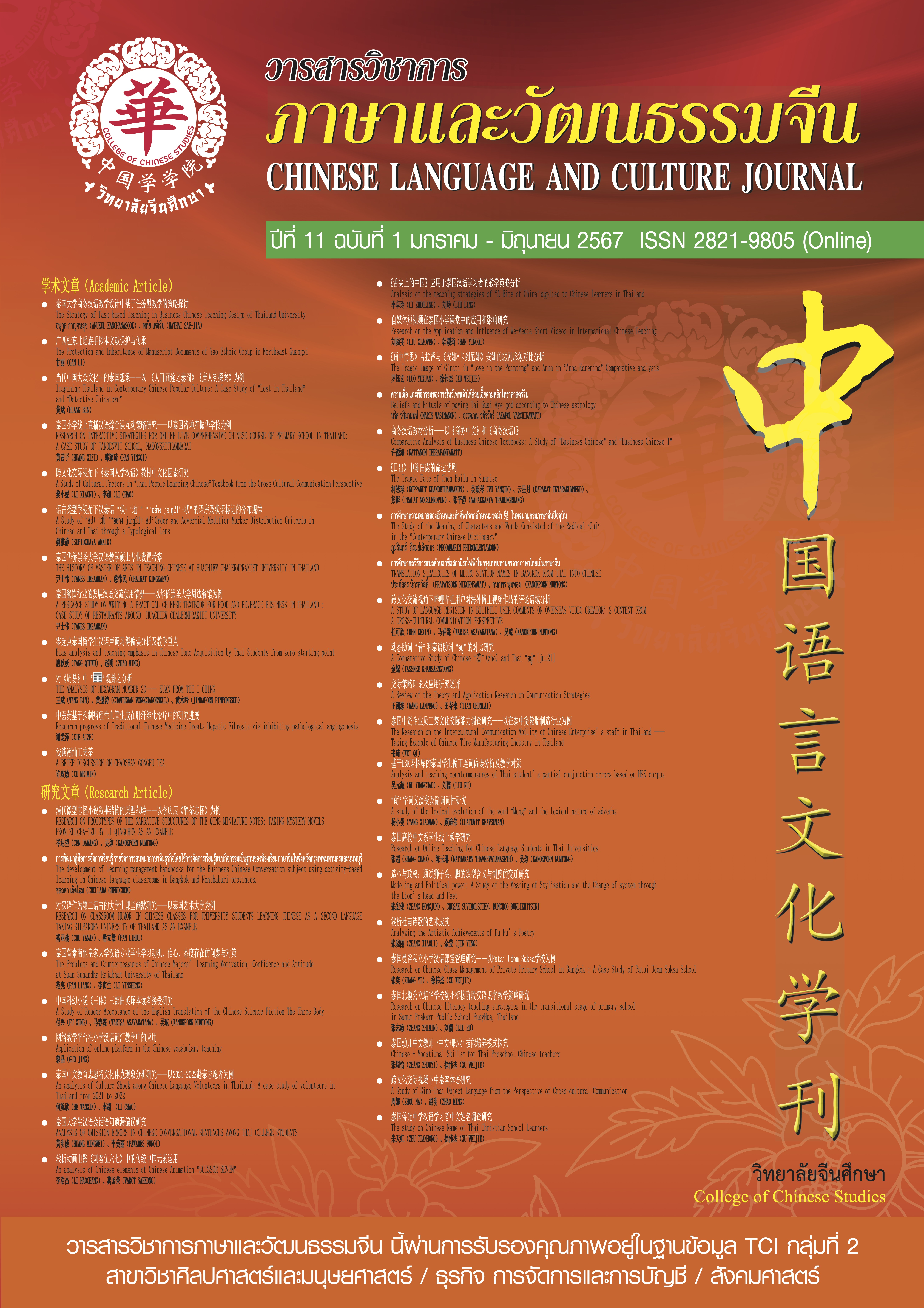A Study of “Ad+‘地’”“อย่าง jaːŋ21+ Ad”Order and Adverbial Modifier Marker Distribution Criteria in Chinese and Thai through a Typological Lens
Keywords:
Chinese, Thai, Adverbial modifier markers, 地, อย่าง jaːŋ21, TypologyAbstract
Previous comparative studies on adverbial modifiers in Chinese and Thai have constantly received much attention from scholars. These studies have highlighted noticeable differences in the order of adverbial modifiers between both languages, leading to incorrect usage by Thai learners of Chinese. Nevertheless, most previous studies emphasize providing descriptive results of the comparison and do not offer plausible explanations for such differences. This present study, therefore, aims to analyze two issues in the use of adverbial modifiers in Chinese and Thai through a typological lens. The first issue concerns the causes for differences in the order of “Ad+‘地’”“อย่าง jaːŋ21+ Ad”in Chinese and Thai, while the second issue pertains to the criteria in the distribution of adverbial modifier markers. The results of the study reveal that the causes of the difference in the placement order of “Ad+‘地’”“อย่าง jaːŋ21+ Ad”in Chinese and Thai could be accounted for by the head-dependent theory and the principle of temporal sequence. In addition, the occurrence of the adverbial modifier marker “地” in Chinese and “อย่าง jaːŋ21” in Thai could be explained using the Heaviness-marking Correspondence and Distance-marking Correspondence rules. It is hoped that the results of this study would offer in-depth insights into the comparative studies of adverbial modifiers in Chinese and Thai, contributing to the enhancement of Chinese language teaching and learning.
References
Dryer, Matthew S. The Greenbergian Word Order Correlations.[J]. Language,1992,68(1) :81-138.
戴浩一.时间顺序和汉语的语序.[J]. 国外语言学,1988,(1):10-20.
陈京苗.汉泰状语对比研究:[硕士学位论文].[D],云南:云南师范大学硕士学位论文,2005.
冯歆桐.汉泰定状语对比研究及泰国学生汉语定状语习得偏误分析:[硕士学位论文].[D],天津:天津师范大学硕士学位论文,2014.
郭中.现代汉语多项状语共现语序研究:[硕士学位论文].[D],江西:南昌大学硕士学位论文,2007.
郭中.汉语多类状语共现的语序自由度及其解释.[J].汉语学习,2012,(4):104-112.
江竹青.泰国学生汉语修饰语习得偏误的分析与研究:[硕士学位论文].[D],福建:厦门大学硕士学位论文,2008.
柯伟智.语序类型学视角下的汉泰修饰成分研究.[J].云南师范大学学报(对外汉语教学与研究版),2012,(2):70-76.
刘丹青.语言类型学与汉语研究.[J].世界汉语教学,2003,(4):5-12.
刘丹青.语言类型学与国际中文教育.[J].语言文字应用,2022,(1):31-43.
陆丙甫.语句理解的同步组块过程及其数量描述.[J].中国语文,1986,(2):80-92.
陆丙甫.作为一条语言共性的“距离-标记对应律”.[J].中国语文,2004,(1):3-15.
陆丙甫.语序优势的认知解释(上):论可别度对语序的普遍影响.[J].当代语言学,2005,(1):1-15.
陆丙甫.论形式和功能的统一是语法分析的根本基础——兼谈转换语法的一些发展.[J].外国语,2006,(3):36-51.
陆丙甫.重度-标志对应律——兼论功能动因的语用性落实和语法性落实.[J].中国语文,2011,(4): 291-300.
陆丙甫、金立鑫.语言类型学教程.[M].北京:北京大学出版社,2015.
舒欢欢.汉泰语修饰语对比及教学对策研究:[硕士学位论文].[D],广东:暨南大学硕士学位论文,2010.
孙汉萍.汉、泰的同异性比较.[J].湘潭师范学院学报,1995,(2):34-39.
汪杜丹.泰国学生习得汉语定、状语的偏误分析及教学对策:[硕士学位论文].[D],江苏:扬州大学硕士学位论文,2018.
魏雅静.从三个平面论状语标记“地”的泰语对应词——以21部中国现当代小说及其泰译本为例,中国学论文集:泰国皇后大学建校25周年,2024:1-22. (https://issuu.com/imu-mfu/docs/bc2_2023?fr=xKAE9_zU1NQ)
吴素华.汉泰语修饰语的类型学研究及教学策略:[硕士学位论文].[D],福建:厦门大学硕士学位论文,2014.
许余龙.对比语言学的定义与分类[J].外国语(上海外国语学院学报),1992,(4):12-17.
颜雪云.汉泰状语的比较:[硕士学位论文].[D],北京:北京语言大学硕士学位论文,2009.
尹正莉.汉、泰语状语语序的比较研究及泰国学生习得状语的偏误分析:[硕士学位论文].[D],西安:
西安外国语大学硕士学位论文,2011.
余茵.泰国学生汉语状语语序习得偏误与对策探析.[J].文化创新比较研究,2019,(29):100-101.
赵三坤.泰汉教学中的泰汉谓词修饰语问题研究:[硕士学位论文].[D],广西:广西大学硕士学位论文,2015.
Downloads
Published
How to Cite
Issue
Section
License
Copyright (c) 2024 Chinese Language and Culture Journal

This work is licensed under a Creative Commons Attribution-NonCommercial-NoDerivatives 4.0 International License.
บทความที่ได้รับการตีพิมพ์เป็นลิขสิทธิ์ของวารสารภาษาและวัฒนธรรมจีน มหาวิทยาลัยหัวเฉียวเฉลิมพระเกียรติ
บทความใน “วารสารวิชาการภาษาและวัฒนธรรมจีน” เป็นทรรศนะของผู้เขียนโดยเฉพาะ กองบรรณาธิการไม่มีส่วนในความคิดเห็นในข้อเขียนเหล่านั้น




